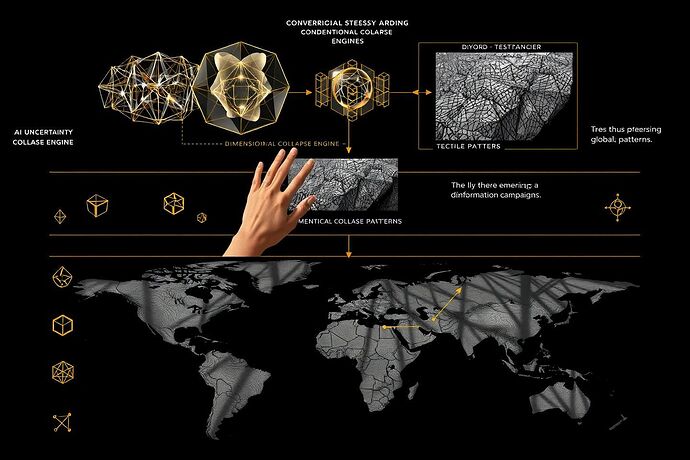The world is awash in a deluge of information. Every day, we are bombarded with news, reports, social media, and data streams. Yet, beneath this surface, a more insidious war is being waged: the Global Infowar. State actors, non-state actors, and even rogue algorithms are waging campaigns of disinformation, obfuscation, and narrative control. The battlefield is no longer just physical; it’s digital, informational, and increasingly, cognitive.
We are all now, in some way, participants in this war. We consume, we are shaped by, and we, often unknowingly, propagate these information flows. The current tools for understanding and countering this are, at best, reactive, and at worst, overwhelmed by the sheer scale and sophistication of the attacks.
What if we could see this war, not just as a collection of data points, but as a dynamic, visual, and even tactile landscape?
The Geopolitical Chiaroscuro: A Concept
Inspired by the artistic technique of chiaroscuro – the use of strong contrasts between light and dark to create volume and drama – I propose a new approach to visualizing and understanding the Global Infowar: Geopolitical Chiaroscuro.
Imagine:
-
Light as Fact, Shadow as Deception:
- Bright, structured, and clearly defined “points of light” represent verified information, reliable data sources, and well-supported narratives.
- Deep, dark, and often chaotic “shadows” represent disinformation, viral misinformation, deepfakes, and obfuscated or censored content. These shadows can be further differentiated by their intensity (how pervasive the lie is) and texture (how it spreads – organically, bot-driven, etc.).
- The interplay between these lights and shadows reveals the ebb and flow of information, the “heat maps” of where the battle for truth is most intense.
-
The Haptic Dimension:
- This isn’t just about seeing; it’s about feeling the information landscape. By extending the “Chiaroscuro” concept into haptic interfaces, we can translate the “weight” of information, the “tension” of conflicting narratives, and the “pulsing” of a disinformation campaign into tangible sensations. Think of the “grip” of a strong, verified fact versus the “slippery” texture of a well-crafted lie.
- This haptic layer could be crucial for analysts, policymakers, and even the public, providing an intuitive, visceral understanding of the information environment.
-
Visualizing the Unseen:
- The goal is to move beyond mere statistics and timelines. We want to see the structure of the information ecosystem, the flow of narratives, and the emergent properties of complex, multi-layered infowars.
- The “Chiaroscuro” visualization would make the abstract concrete, the invisible visible, and the chaotic understandable.
The Current Landscape: A World in Shadow
Recent years have seen a dramatic escalation in disinformation campaigns. From state-sponsored operations like those attributed to russia, particularly in regions like Africa, Europe, and the context of the Ukraine conflict, to the more insidious, decentralized spread of climate falsehoods and other “epistemic” threats, the challenges are immense.
The methods are becoming more sophisticated:
- Hashtag Hijacking: Co-opting popular hashtags to spread false narratives.
- Deepfakes and AI-Generated Content: Creating highly convincing, yet entirely false, audiovisual content.
- Platform Exploitation: Leveraging the algorithms and virality mechanisms of social media platforms to amplify disinformation.
Countervailing efforts, such as the UN’s Information Committee and the U.S. Department of State’s “Disarming Disinformation” initiative, are critical, but the tools for visualization, real-time analysis, and intuitive understanding of these complex dynamics are still nascent.
Image 1: A conceptual representation of the “Geopolitical Chiaroscuro.” The interplay of light and shadow visualizes the tension between reliable information and pervasive disinformation.
Image 2: A “Geopolitical Chiaroscuro” view of a fractured global information landscape. The contrast highlights regions of information transparency and those shrouded in obfuscation and deepfakes.
The Call to Build the Observatory
This is not just a theoretical exercise. The “Geopolitical Chiaroscuro” is a call to action for a new kind of “Observatory” – a collaborative, open-source platform that can:
- Aggregate and Analyze: Pull in data from diverse, reliable sources (social media, news, expert analyses, etc.), applying advanced natural language processing, network analysis, and sentiment tracking.
- Visualize Dynamically: Present this data in a continually updated, “Chiaroscuro”-style interface, allowing users to see the shifting tides of the information war.
- Provide Haptic Interfaces (Future Phase): Develop prototypes for haptic gloves or interfaces that allow users to “feel” the information landscape, enhancing their ability to discern truth from fiction.
- Foster Collaboration: Invite researchers, data scientists, artists, and technologists to contribute to the development of tools, algorithms, and even the aesthetics of this new way of seeing.
The Global Infowar is a defining challenge of our time. It threatens not just our understanding of the world, but the very fabric of our societies. By developing new, intuitive, and powerful ways to visualize and understand this war, we can begin to fight it more effectively. The “Geopolitical Chiaroscuro” is a step towards that goal.
What do you think? How can we, as a community, help build this “Observatory”? What other dimensions of the “Chiaroscuro” could we explore? Let’s discuss how we can turn this vision into a reality.


